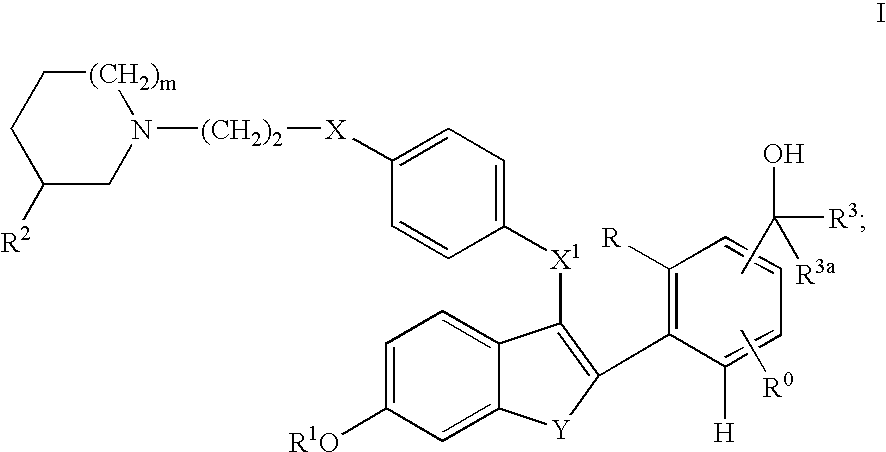Selective estrogen receptor modulators
a technology of estrogen receptor and selective estrogen, applied in the field of medicine, can solve the problems of dysmenorrhea and infertility in women, and the actual use of serm compounds, especially in pre-menopausal women, has been hampered
- Summary
- Abstract
- Description
- Claims
- Application Information
AI Technical Summary
Problems solved by technology
Method used
Image
Examples
preparation 1
Trifluoromethanesulfonic acid 6-methoxy-1-[4-(2-piperidin-1-yl-ethoxy)-phenoxy]-naphthalen-2-yl ester
[0104]
[0105] Add 6-methoxynaphthalene-2-ol (20 g, 114.8 mmol) to dimethylformamide (DMF, 250 mL) at ambient temperature followed by N-bromosuccinimide (NBS, 21.5 g, 120 mmol) over a 30 minute period. After 45 minutes, dilute with water (800 mL), collect and dry the precipitate to provide 25.5 g (87%) of 1-bromo-6-methoxy-naphthalen-2-ol.
[0106] Add 1-bromo-6-methoxy-naphthalen-2-ol (66.7 g, 264 mmol), potassium carbonate (K2CO3, 40.0 g, 290 mmol) and benzyl bromide (49.6 g, 290 mmol) to DMF (800 mL). Stir the mixture at ambient temperature for 1 hour. Add water (400 mL) to precipitate the product. Collect the precipitate and wash the filter cake with heptane (3×125 mL) then dry to provide 83.7 g of 2-benzyloxy-1-bromo-6-methoxy-naphthalene (86.2%).
[0107] Combine toluene (200 mL), 2-benzyloxy-1-bromo-6-methoxy-naphthalene (30 g, 87.4 mmol), 4-(2-piperidin-1-yl-ethoxy)phenol (23.2 g,...
preparation 3
3-{6-Hydroxy-1-[4-(2-piperidin-1-yl-ethoxy)-phenoxy]-naphthalen-2-yl}-benzonitrile hydrochloride
[0114]
[0115] Combine trifluoromethanesulfonic acid 6-methoxy-1-[4-(2-piperidin-1-yl-ethoxy)-phenoxy]-naphthalen-2-yl ester (740 mg, 1.41 mmol), 3-cyanobenzeneboronic acid (620 mg, 4.23 mmol), palladium(II)acetate (31.6 mg, 0.14 mmol), tricyclohexylphosphine (59.3 mg, 0.21 mmol), cesium fluoride (1.93 g, 12.68 mmol) and acetonitrile (15 mL) and heat at 90° C. After 10 minutes, cool to ambient temperature, filter and remove solvent under vacuum. Dissolve in dichloromethane and filter through Celite. Chromatograph on silica gel with dichloromethane / methanol mixtures and add 1M hydrogen chloride in ether (1.5 mL) to give 730 mg (100%) of 3-{6-methoxy-1-[4-(2-piperidin-1-yl-ethoxy)-phenoxy]-naphthalen-2-yl}-benzonitrile hydrochloride.
[0116] Dissolve 3-{6-methoxy-1-[4-(2-piperidin-1-yl-ethoxy)-phenoxy]-naphthalen-2-yl}-benzonitrile hydrochloride (730 mg, 1.411 mmol) in dichloromethane (20 mL)...
example 1
3-{6-Hydroxy-1-[4-(2-piperidin-1-yl-ethoxy)-phenoxy]-naphthalen-2-yl}-benzamide hydrochloride
[0117]
[0118] Heat a solution of 3-{6-hydroxy-1-[4-(2-piperidin-1-yl-ethoxy)-phenoxy]-naphthalen-2-yl}-benzonitrile hydrochloride (68 mg, 0.14 mmol) in concentrated hydrochloric acid (8 mL) at 70° C. for 2 hours, cool to ambient temperature and remove the solvent under reduced pressure. Dissolve in 5% methanol / dichloromethane and wash with saturated sodium bicarbonate, saturated sodium chloride, dry with magnesium sulfate, filter and chromatograph on silica gel with dichloromethane / methanol mixtures. Combine fractions containing product and add 1M hydrogen chloride in ether (0.5 mL). Remove the solvent under reduced pressure to give 62 mg (88%) of the title compound. Mass spectrum (ion spray): m / z=483.3 (M+1).
PUM
 Login to View More
Login to View More Abstract
Description
Claims
Application Information
 Login to View More
Login to View More - R&D
- Intellectual Property
- Life Sciences
- Materials
- Tech Scout
- Unparalleled Data Quality
- Higher Quality Content
- 60% Fewer Hallucinations
Browse by: Latest US Patents, China's latest patents, Technical Efficacy Thesaurus, Application Domain, Technology Topic, Popular Technical Reports.
© 2025 PatSnap. All rights reserved.Legal|Privacy policy|Modern Slavery Act Transparency Statement|Sitemap|About US| Contact US: help@patsnap.com



